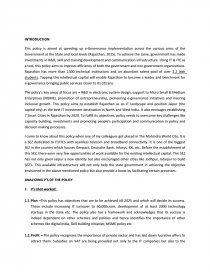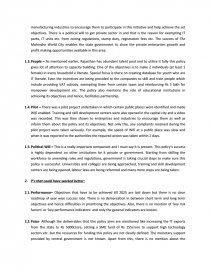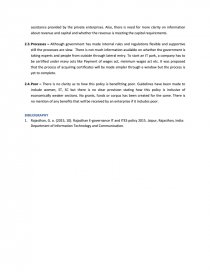Rajasthan E-Governance It and Ites Policy 2015
Essay by sups • July 20, 2016 • Research Paper • 1,164 Words (5 Pages) • 1,187 Views
Rajasthan E-Governance IT and ITES policy 2015 |
Vedica Scholars Programme for Women |
Supriya Singhal |
INTRODUCTION
This policy is aimed at speeding up e-Governance implementation across the various arms of the Government at the State and local levels (Rajasthan, 2015). To achieve the same, government has made investments in R&D, skill and training development and communication infrastructure. Using IT & ITE as a tool, this policy aims to improve efficiency of both the government and non government organizations. Rajasthan has more than 1300 technical institutions and an abundant talent pool of over 2.2 lakh students. Tapping this intellectual capital will enable Rajasthan to become a leader and benchmark for e-governance bringing public services closer to its citizens.
The policy’s key areas of focus are – R&D in electronic system design, support to Micro Small & Medium Enterprises (MSME), promotion of entrepreneurship, pioneering e-governance initiatives and insuring inclusive growth. This policy aims to establish Rajasthan as an IT landscape and position Jaipur (the capital city) as the best IT investment destination in North and West India. It also envisages establishing 7 Smart Cities in Rajasthan by 2020. To fulfill its objectives, policy needs to overcome key challenges like capacity building, investments and promoting people’s participation and communication in policy and decision making processes.
I came to know about this policy when one of my colleagues got placed in The Mahindra World City. It is a SEZ dedicated to IT/ITES with seamless telecom and broadband connectivity. It is one of the biggest SEZ in the country which houses Genpact, Deutsche Bank, Infosys, EXL etc. Before the establishment of this SEZ, there were very few opportunities of work available for the existing intellectual capital. This SEZ has not only given Jaipur a new identity but also encouraged other cities like Jodhpur, Udaipur to build SEZ’s. This available infrastructure will not only help the state government in achieving the objective envisioned in the above mentioned policy but also provide a boost by facilitating certain processes.
ANALYZING P’S OF THE POLICY
- P’s that worked:
- Plan –This policy has objectives that are to be achieved till 2025 and which will decide its success. These include increasing IT turnover to 50,000crore, development of at least 2000 technology startups in the state etc. The policy also has a framework and acknowledges that its success is indeed dependent on other schemes and policies and hence identifies the importance of other schemes like digital India, Skill building initiative, MSME policy etc.
- Profit – The policy recognizes the importance of private sector and has laid down lucrative offers to attract them. Subsidies on VAT are being provided not only to the IT companies but also to the manufacturing industries to encourage them to participate in this initiative and help achieve the set objectives. There is a political will to get private sector in and that is the reason for exempting IT parks, IT units etc. from zoning regulations, stamp duty, registration fees etc. The success of The Mahindra World City enables the state government to show the private enterprises growth and profit making opportunities available in this area.
- People – As mentioned earlier, Rajasthan has abundant talent pool and to utilize it fully this policy gives lot of attention to capacity building. One of the objectives is to make 2 individuals (at least 1 female) in every household e literate. Special focus is there on creating database for youth who are IT literate. Even the incentives are being provided to the companies to skill and train people which include providing VAT subsidy, exempting them from certain taxes and reimbursing Rs 5 lakh for manpower development etc. The policy also mentions the role of educational institutions in achieving its objectives and hence, facilitates partnership.
- Pilot – There was a pilot project undertaken in which certain public places were identified and made Wifi enabled. Training and skill development centers were also opened in the capital city and a video was recorded. This was then shown to enterprises and industries to encourage them as well as inform them about the policy and its objectives. Not only this, any complaints received during the pilot project were taken seriously. For example, the speed of Wifi at a public place was slow and when it was reported to the authorities the required action was taken within 2 days.
- Political Will – This is a really important component and I must say it is present. This policy’s success is highly dependent on other institutions be it private or government. Starting from skilling the workforce to amending rules and regulations, government is taking crucial steps to make sure this policy is successful. Universities and colleges are being approached, training and skill development centers are being opened, labour laws are being reformed and many more steps are being taken.
- P’s that could have worked better:
- Performance– Objectives that have to be achieved till 2025 are laid down but there is no clear roadmap of year wise success rate. There is no demarcation in between short term and long term objectives and hence difficulties in prioritizing the objectives. Also, there is no mention of ‘key risk factors’ or ‘key performance indicators’ and only the general indicators are known.
- Paisa- Although the deliverables that this policy aims are mentioned like increasing the IT exports from the state to Rs 5000crore, setting a SME fund of Rs 155crore to support high technology sectors etc. but the resources for funding this policy are not clearly defined. The monetary support provided by central government is not known. Apart from this, there is no mention about the assistance provided by the private enterprises. Also, there is need for more clarity on information about revenue and capital and whether the revenue is meeting the capital requirements.
- Processes – Although government has made internal rules and regulations flexible and supportive still the processes are slow. There is not much information available on whether the government is taking experts and people from outside through lateral entry. To start an IT park, a company has to be certified under many acts like Payment of wages act, minimum wages act etc. It was proposed that the process of acquiring certificates will be made simpler through e window but the process is yet to complete.
- Poor – There is no clarity as to how this policy is benefitting poor. Guidelines have been made to include women, ST, SC but there is no clear provision stating how this policy is inclusive of economically weaker sections. No grants, funds or corpus has been created for the same. There is no mention of any benefits that will be received by an enterprise if it includes poor.
BIBLIOGRAPHY
- Rajasthan, G. o. (2015, 10). Rajasthan E-governance IT and ITES policy 2015. Jaipur, Rajasthan, India: Department of Information Technology and Communication.
...
...



